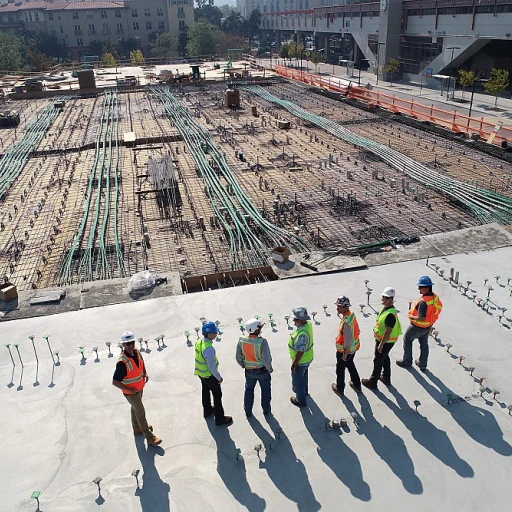
Understanding the Role of Headhunters in Succession Planning
The Importance of Headhunters in Succession Strategies
Understanding how headhunters contribute to succession planning is pivotal for any company aiming to ensure a seamless transition in pivotal roles. Headhunters, often underutilized or misunderstood, play a crucial role in identifying and placing the right candidates in open positions which require specialized skills or leadership abilities. Headhunters focus on sourcing candidates who align with specific job requirements, ensuring the selected individuals can drive the organization forward even in complex environments. These recruiters leverage extensive databases and networks, particularly on platforms like LinkedIn, to identify individuals who might not be visible through conventional job search channels. By concentrating on passive job seekers—those who are not actively applying for jobs—headhunters fill a crucial gap in the hiring process, providing access to a wealth of hidden talent. A key benefit of engaging headhunters is their depth of market knowledge and expertise. These professionals offer insights that are not only beneficial to large corporations but also invaluable to smaller organizations. Whether working in a corporate environment or within nonprofit sectors, headhunters can steer the succession planning process. For further nuance, examining compensation for nonprofit executive directors can illuminate specific challenges faced in different sectors. In leveraging LinkedIn, headhunters simplify the candidate search by utilizing features like the recruiters' open-to-work tool or the sales navigator, which pinpoints individuals open to job opportunities. Consequently, ensuring your LinkedIn profile is optimized not only enhances visibility but also improves your chances of being found by these professionals. It’s critical to present a well-rounded and updated profile photo, add pertinent skills, and include keywords relevant to your industry expertise. This strategy invites headhunters to click on and engage with your profile, marking a significant step towards successful succession planning.Optimizing Your LinkedIn Profile to Attract Headhunters
Crafting a Standout LinkedIn Profile
To ensure your LinkedIn profile is visible to recruiters, especially those specializing in succession planning, optimizing your profile is paramount. Think of your LinkedIn profile as your digital business card. Job seekers looking to connect with headhunters need to carefully curate their profiles to make a lasting impression.
- Profile Photo: A professional, clear headshot is a must. It helps recruiters connect a face to your name, making your profile more personable and approachable.
- Headline and Summary: Your headline should reflect your job goals and attract job seekers open to work. Use keywords like "succession planning" or "succession strategist." In your summary, provide a succinct yet compelling overview of your skills and achievements related to succession planning.
- Experience and Skills: Clearly outline your previous roles and responsibilities. Highlight experiences that involve leadership, strategy, and planning. Add skills pertinent to succession planning to increase visibility.
- Recommendations: Earn endorsements from past colleagues or managers to boost credibility. Recommendations serve as testimonials of your aptitude and work ethic.
- Use the #OpenToWork Feature: Make use of LinkedIn's feature that signals to recruiters that you are open to opportunities. This increases your profile's visibility in recruiter searches.
Recruiters using LinkedIn’s search features heavily rely on keywords. Therefore, incorporating relevant terms like "succession planning", "leadership development", and "talent management" in your profile ensures you surface more often in their searches. Each element of your profile works together to enhance your personal brand and make your profile a magnet for the right job opportunities and headhunters.
To gain a deeper understanding of structuring your profile in alignment with succession planning principles and bylaws, explore this detailed resource.
Utilizing LinkedIn's Search Features to Find Headhunters
Exploring LinkedIn's Search and Networking Tools
To find the right headhunter for succession planning, it's essential to understand how to utilize LinkedIn's search features effectively. This platform can significantly streamline your search process, making it easier to identify and engage with headhunters who specialize in your industry.
Here are some strategies to enhance your job search on LinkedIn:
- Leverage LinkedIn's Search Bar: Use the search bar at the top of the LinkedIn homepage to input specific keywords related to your field, such as "succession planning headhunters" or "executive recruiters". This will generate a list of potential profiles that align with your search criteria.
- Utilize the Filters: Once you've conducted a basic search, take advantage of LinkedIn's filtering options to narrow down results based on location, industry, and experience of recruiters. These filters help you find candidates that are most relevant to your needs.
- Use the Sales Navigator: If you have access to LinkedIn's Sales Navigator, it’s an excellent tool for deepening your search. It offers more advanced search capabilities, allowing you to pinpoint specific criteria and increase visibility to a targeted audience of headhunters.
- Activate the Open to Work Feature: By enabling this feature on your LinkedIn profile, you signal to recruiters that you are open to new job opportunities. This increases your chances of being approached by headhunters actively looking to fill critical roles.
It's crucial to remember that building a strong LinkedIn profile, made visible to recruiters and reflecting your professional achievements, complements these search efforts. By strategically using LinkedIn search tips and optimizing your profile, you'll boost your chances of finding the right headhunter to assist in succeeding in your company’s succession planning goals.
Engaging with Headhunters on LinkedIn
Building Meaningful Connections with Recruiters
Engaging with headhunters on LinkedIn involves more than just a connection request. It's about creating meaningful interactions that can lead to future opportunities. Here’s how:
- Customize Your Connection Requests: When reaching out to headhunters, a personalized note can make a significant difference. Mention mutual connections or particular reasons for your interest, such as their expertise in a relevant field or an open position they are hiring for.
- Stay Active and Engaged: Comment on and share posts relevant to your industry. This not only keeps you visible on the platform but demonstrates your passion and knowledge.
- Utilize LinkedIn Messaging: For pre-existing recruiters you’re connected with, send a courteous message expressing your interest in relevant job opportunities. Remind them of your qualifications and career goals without coming across as overly salesy.
Through these steps, you can ensure that you are making an impression that lasts, effectively opening doors to potential roles that match your skills and aspirations. A strategic approach can position you in the pipeline for succession opportunities within your industry.
Evaluating Potential Headhunters for Your Needs
Assessing Collaborations with Prospective Headhunters
Finding the right headhunters for your succession planning needs involves more than just finding someone who can fill the role. It requires an in-depth evaluation of their ability to understand your company's culture, objectives, and future aspirations. Here's how to effectively evaluate potential headhunters:- Review Their Track Record: Investigate the headhunter's previous work and achievements, especially in similar industries. This could involve looking at case studies, client testimonials, and previously filled roles. A LinkedIn search can reveal endorsements from job seekers and hiring companies alike, giving insight into their proficiency.
- Verify Their Network: The strength of a headhunter's professional network largely determines their success rate. Make sure they are visible to recruiters and have connections across LinkedIn that can increase your job opportunities. A wide network means they have access to a larger pool of candidates, ensuring they'll find headhunters ideally suited for your company’s needs.
- Analyze Their Communication Style: Communication is key. Ensure that the headhunter maintains open work communication channels throughout the hiring process. Utilize LinkedIn's messaging features or direct emails to assess their response times and approach.
- Align with Your Company’s Vision: The headhunter should have a keen understanding of your company’s ethos and goals. They should be able to articulate how they plan to search for candidates that align with your long-term vision. Discuss these aspects in your preliminary meetings.
- Use Sales Navigator for Enhanced Insights: To gain further insights into potential recruiters, use LinkedIn’s Sales Navigator feature. It enhances profiles visibility and allows you to view their interactions and activity levels. By doing so, you can gauge the recruiters’ engagement with other LinkedIn members.
Leveraging LinkedIn Groups and Networks
Harnessing LinkedIn Groups and Networks for Succession Hiring
Navigating LinkedIn can be an overwhelming experience, especially when your goal is to find the best headhunter to assist in succession planning. Fortunately, LinkedIn Groups and Networks offer a powerful avenue to connect with industry experts and recruiters focusing on specific sectors, thus magnifying your job search efforts. LinkedIn Groups provide a vital gathering space for like-minded professionals and recruiters. Joining these groups elevates your visibility among headhunters and offers an opportunity to engage in discussions, gather insights, and showcase your expertise. By sharing relevant content, participating in discussions, and asking thoughtful questions, you increase your chances of being noticed by potential recruiters. Consider these tips when utilizing LinkedIn Groups:- Find Relevant Groups: Use the LinkedIn search bar to locate groups related to your industry or those focusing on succession planning and headhunting.
- Active Participation: Engage actively with posts by liking, commenting, or sharing your thoughts. An active presence portrays you as an involved job seeker.
- Share Value: Post informative content or insights to demonstrate your understanding and add value to the group discussions.
- Networking: Connect with group members, especially those identified as recruiters open to collaboration, to expand your professional network effectively.
- Utilize the 'People You May Know' feature: LinkedIn's algorithm suggests professionals who share your interests or work background, enabling you to expand your network strategically.
- Leverage Sales Navigator: This feature is particularly useful for identifying key influencers in your industry, allowing more precise targeting of your connections.
- Engage Directly: Reach out to potential headhunters with a clear and concise message demonstrating your interest in collaborative efforts, aiming to fill succession roles efficiently.












